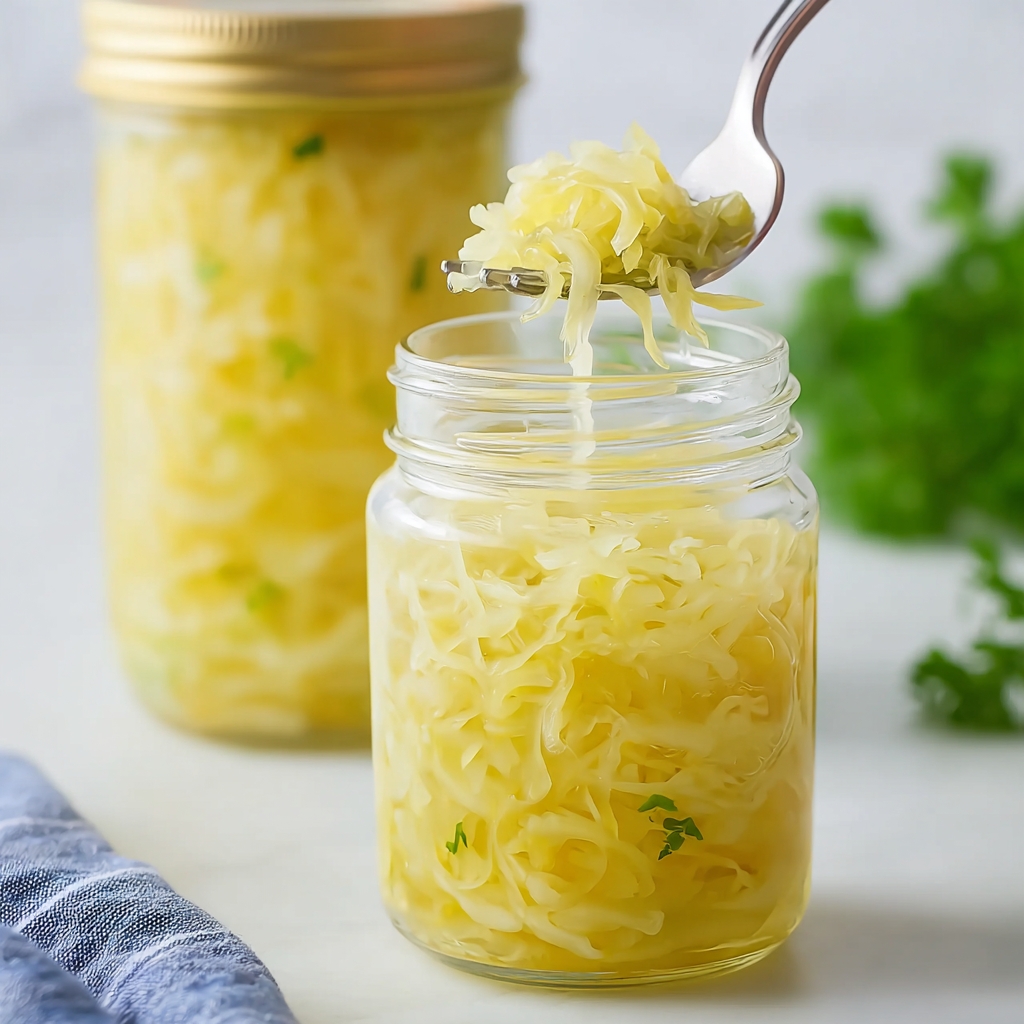Quick Sauerkraut – Tangy, Tender, and Ready in Under an Hour
1. Introduction to the Recipe
Whether you’re craving a tangy side for your bratwurst or looking to add probiotics to your plate without the days-long fermentation process, Quick Sauerkraut is the perfect shortcut. This speedy version of traditional fermented cabbage offers all the tart, tender flavor you love—minus the wait. In under 60 minutes, you can have a warm or chilled batch of sauerkraut ready to serve alongside sausages, sandwiches, roasted meats, or even tossed into salads for an acidic crunch.
This Quick Sauerkraut recipe uses green cabbage, sliced thinly for maximum tenderness and even cooking. A combination of apple cider vinegar and white vinegar gives it that distinctive tang, while seasonings like mustard seeds, garlic powder, and onion powder create a savory, aromatic depth. There’s no fermentation here—instead, it’s gently simmered in a vinegar-brine solution to achieve a similar taste profile in a fraction of the time.
If you’re curious about how traditional sauerkraut is made, check out this guide to lacto-fermentation to explore the long-form method. Or if you’re looking for a hearty dish to pair it with, this German bratwurst with sauerkraut recipe is a great match.
Easy to customize and wonderfully versatile, this recipe is perfect for beginners or anyone short on time. In less than an hour, you’ll have a jar (or pan) full of tender, vibrant sauerkraut that’s flavorful enough to eat by the forkful and simple enough to make on any weeknight. Let’s dive into this Quick Sauerkraut recipe that balances speed with satisfying, classic taste.
2. Basic Recipe: Ingredients and Instructions
Print
Quick Sauerkraut – Tangy, Tender, and Ready in Under an Hour
Description
Make tangy, tender Quick Sauerkraut in under an hour with cabbage, vinegar, and simple spices. Perfect as a side or topping.
Ingredients
-
1 head green cabbage, thinly sliced (about 2.5 lbs, cored and outer leaves removed)
-
1 cup water
-
½ cup apple cider vinegar
-
½ cup white distilled vinegar
-
2 teaspoons salt
-
2 teaspoons granulated sugar
-
½ teaspoon black pepper
-
½ teaspoon garlic powder
-
½ teaspoon mustard seeds
-
½ teaspoon onion powder
Instructions
-
Prepare the Cabbage:
Remove the outer leaves and core from the cabbage. Slice the cabbage thinly using a sharp knife or mandolin. -
Create the Brine:
In a large pot or deep skillet, combine water, apple cider vinegar, white vinegar, salt, sugar, pepper, garlic powder, mustard seeds, and onion powder. Stir until the salt and sugar dissolve. -
Add the Cabbage:
Add the sliced cabbage to the pot. Toss it gently in the liquid using tongs to ensure it’s well coated. -
Simmer Gently:
Bring the mixture to a gentle simmer over medium heat. Cover partially and cook for 25–30 minutes, stirring occasionally, until the cabbage is tender and has absorbed the flavor. -
Taste and Adjust:
Taste the sauerkraut and adjust the seasoning to your preference—add more vinegar for tang, or more salt to enhance the flavor. -
Cool and Serve:
Serve warm as a side or let it cool and refrigerate for at least 30 minutes to enhance the flavors. It keeps well chilled.
Notes
The thinner the cabbage, the faster and more evenly it cooks.
You can use all apple cider vinegar for a sweeter, more rounded flavor.
Try tossing in a few caraway seeds for a more traditional touch.
3. Advanced Techniques
Enhancing Flavor with Caramelized Cabbage Base
To deepen the flavor, lightly caramelize a portion of the cabbage before simmering. Set aside one cup of sliced cabbage and sauté it in a bit of oil until golden brown, then add it back to the pot with the rest of the raw cabbage. This layering adds a touch of natural sweetness and complexity that mimics the slow fermentation depth of traditional kraut.
Infusing with Aromatics and Herbs
Infuse your sauerkraut with fresh or dried herbs for a gourmet twist. Bay leaves, dill weed, or fresh thyme sprigs added during cooking bring out earthy undertones and balance the acidity. Remove before serving to keep texture clean. You can also experiment with allspice berries or fennel seeds for a unique flavor profile.
Adjusting Texture to Preference
If you prefer crunchier sauerkraut, reduce cooking time to 15–20 minutes, just enough to soften but retain bite. For a silkier texture, simmer longer (up to 40 minutes) over low heat, stirring occasionally. You can also split the batch and cook half longer, then combine for a multidimensional texture.
Batch Customization with Add-Ins
Add julienned apples or thinly sliced onions to your sauerkraut during the simmer for sweet and savory balance. A splash of white wine or beer can also give it a slightly fermented essence. These additions elevate the flavor and allow you to personalize the dish to suit various entrees or occasions.
Achieving Fermented-Like Acidity
To mimic the taste of fermented sauerkraut even more, let the cooked sauerkraut sit overnight in the fridge. As it chills, the flavors intensify and mellow, offering a more developed, sour tang—similar to traditional kraut without the wait. A pinch of ascorbic acid (vitamin C powder) can also enhance the tang if desired.
See more advanced recipes at cookingwhite.com
4. Storage, Shelf Life, and Maintenance Tips
Refrigeration is Key
After cooking, store cooled sauerkraut in a clean airtight container in the refrigerator. It will keep for up to 2 weeks and the flavor improves over time. Letting it rest overnight is highly recommended for the best flavor experience.
Freezing for Long-Term Storage
Freeze sauerkraut in freezer-safe containers or bags, removing excess air to prevent freezer burn. It can last up to 3 months frozen. Thaw in the fridge and reheat gently to serve. Note that freezing may slightly soften the texture, but the flavor remains intact.
Keep Moisture Balanced
If your sauerkraut appears dry during storage, reheat it with a small splash of water or vinegar to restore moisture. Alternatively, if it’s too wet, strain some of the brine before reheating or serving cold.
Preventing Off-Flavors
Always store sauerkraut in non-reactive containers like glass or plastic. Avoid metal containers (unless stainless steel) as the vinegar can react with metal and alter the flavor.
Refreshing After Storage
To perk up leftovers, toss sauerkraut with a touch of fresh vinegar, salt, or a drizzle of olive oil just before serving. A quick sauté with garlic or shallots also revives flavor beautifully.
5. Dietary Adaptations and Substitutions
Low-Sodium Option
Reduce salt by half or use a potassium-based salt substitute. Keep in mind that less salt may slightly impact flavor preservation, so be sure to consume within a few days if making low-sodium batches.
Sugar-Free Variation
Omit granulated sugar entirely or substitute with stevia, monk fruit, or a small amount of honey. This change may make the sauerkraut more acidic, so consider adjusting vinegar levels slightly to balance the tang.
All-Vinegar or No-Vinegar Adjustments
Prefer one type of vinegar? Use all apple cider vinegar for a sweeter tang, or all white vinegar for a sharper bite. If avoiding vinegar altogether, lemon juice can be used, though it produces a lighter flavor and shorter shelf life.
Low-FODMAP Friendly
Cabbage is moderate in FODMAPs but may be tolerated in small amounts. To make this recipe more gut-friendly, reduce garlic powder and onion powder, and avoid adding raw onions or apples. Stick to a half-serving size for low-FODMAP compliance.
Spice Customization for Sensitive Diets
Leave out black pepper or mustard seeds if you’re cooking for those with spice sensitivities or reflux. You can replace them with a bit of celery seed or caraway for flavor with less irritation potential.
6. FAQs About the Recipe
Can I use red cabbage instead of green?
Yes, red cabbage works well and gives a beautiful magenta hue to the dish. The flavor is slightly bolder, and the vinegar turns pink when cooked. Use the same method, and note it may need slightly more vinegar for balance.
Is this quick sauerkraut fermented?
No—this is a quick-pickled version using vinegar, not lacto-fermentation. It mimics the flavor of traditional kraut but is ready in under an hour, making it ideal for last-minute meals.
Why is my sauerkraut too soft or mushy?
Overcooking is the usual cause. If you prefer crunchy sauerkraut, simmer it for 15–20 minutes instead of 30–40. Be sure to slice the cabbage evenly so it cooks at the same rate.
Can I make this in an Instant Pot or slow cooker?
Yes. For the Instant Pot, use the sauté function for the initial simmer (lid off), cooking for 10–15 minutes. In a slow cooker, cook on high for 1.5 to 2 hours or low for 3–4 hours, covered.
How do I serve quick sauerkraut?
Serve it hot or cold! It’s excellent as a side for sausages, pork chops, or sandwiches. You can also mix it into salads, top it on hot dogs, or pair it with roasted vegetables.
7. Conclusion & Final Thoughts
This Quick Sauerkraut recipe is proof that you don’t need days of fermentation to enjoy the bold, zesty taste of classic kraut. Ready in under an hour, it’s an ideal solution for home cooks who crave that acidic crunch without the commitment of waiting. By simmering cabbage with vinegar, salt, and spices, you create a tangy, aromatic side dish that’s both versatile and delightfully easy.
Whether served warm with bratwurst or chilled atop a Reuben, this recipe adapts to your tastes and schedule. You can tailor the acidity, texture, and spices to suit your preferences, making each batch uniquely yours. Plus, it stores beautifully in the fridge, growing even more flavorful with time. It’s the kind of recipe that becomes a staple—not just for its flavor, but for the flexibility it offers.
So next time you find yourself with a head of cabbage and a craving for something tangy and satisfying, skip the fermentation crock and go straight for this quick version. You’ll get all the flavor, none of the fuss—and it’s sure to be a repeat favorite.

